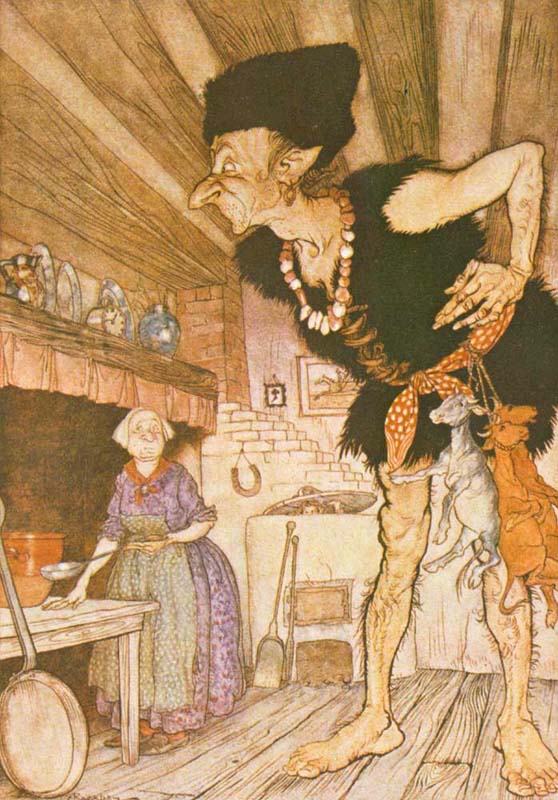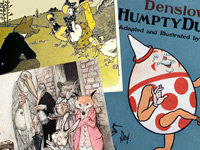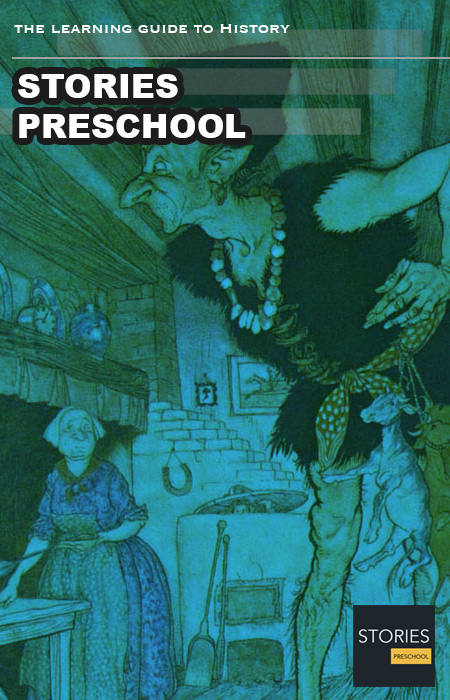Jack and the Beanstalk

"Jack and the Beanstalk" is an English fairy tale. It appeared as "The Story of Jack Spriggins and the Enchanted Bean" in 1734 and as Benjamin Tabart's moralised "The History of Jack and the Bean-Stalk" in 1807. "Felix Summerly" (Henry Cole) popularised the tale in The Home Treasury (1842), and Joseph Jacobs rewrote it in English Fairy Tales (1890). Jacobs' version is most commonly reprinted today and it is believed to be closer to the oral versions than Tabart's because it lacks the moralising. "Jack and the Beanstalk" is the best known of the "Jack tales", a series of stories featuring the archetypal Cornish and English hero and stock character Jack.
According to researchers at the universities in Durham and Lisbon, the story originated more than 5,000 years ago, based on a widespread archaic story form which is now classified by folkorists as ATU 328 The Boy Who Stole Ogre's Treasure.
Story
Jack is a young, poor boy living with his widowed mother and a dairy cow as their only source of income. When the cow stops giving milk, Jack's mother tells him to take it to the market to be sold. On the way, Jack meets an old man who offers "magic beans" in exchange for the cow, and Jack makes the trade. When he arrives home without any money, his mother becomes angry, throws the beans on the ground, and sends Jack to bed without dinner.
During the night, the magic beans cause a gigantic beanstalk to grow, which Jack climbs to a land high in the sky. When Jack finds an enormous castle, he either breaks in or is allowed in by an unusually large woman who feeds him. Soon after, the castle's owner, a giant, returns home. He senses that Jack is nearby, and speaks a rhyme:
Fee-fi-fo-fum!
I smell the blood of an Englishman,
Be he alive, or be he dead,
I'll grind his bones to make my bread.
In the versions in which the giant's wife features, she persades him that he is mistaken. When the giant falls asleep Jack steals a bag of gold coins and makes his escape down the beanstalk.
Jack climbs the beanstalk twice more. He learns of other treasures and steals them when the giant sleeps: first a goose that lays golden eggs (the most common variant is a hen; compare the idiom "to kill the goose that laid the golden eggs."), then a harp that plays by itself. The giant wakes when Jack leaves the house with the harp and chases Jack down the beanstalk. Jack calls to his mother for an axe and before the giant reaches the ground, cuts down the beanstalk, causing the giant to fall to his death. Jack and his mother live happily ever after with the riches that Jack stole.
Origins
"The Story of Jack Spriggins and the Enchanted Bean" was published in the 1734 second edition of Round About Our Coal-Fire. In 1807, Benjamin Tabart published The History of Jack and the Bean Stalk, but the story is certainly older than these accounts. According to researchers at Durham University and the Universidade Nova de Lisboa, the story originated more than 5,000 years ago.
In some versions of the tale, the giant is unnamed, but many plays based on it name him Blunderbore. (One giant of that name appears in the 18th-century "Jack the Giant Killer".) In "The Story of Jack Spriggins" the giant is named Gogmagog.
The giant's cry "Fee! Fie! Foe! Fum! I smell the blood of an Englishman" appears in William Shakespeare's early-17th-century King Lear in the form "Fie, foh, and fum, I smell the blood of a British man." (Act 3, Scene 4), and something similar also appears in "Jack the Giant Killer".
LITERATURE FAIRY TALES

Jack and the Beanstalk Giant - Project Gutenberg eText 17034

Jack and the Beanstalk Giant - Project Gutenberg eText 17034
( Click image to enlarge)
A fairy tale is a type of short story that typically features folkloric fantasy characters, such as dwarves, elves, fairies, giants, gnomes, goblins, mermaids, trolls, or witches, and usually magic or enchantments. Fairy tales may be distinguished from other folk narratives such as legends (which generally involve belief in the veracity of the events described) and explicitly moral tales, including beast fables. The term is mainly used for stories with origins in European tradition and, at least in recent centuries, mostly relates to children's literature.
Read More » List of Fairy tales »
RESOURCES
This article uses material from the Wikipedia articles "List of fairy tales", "Fairy tale" and "Jack and the Beanstalk", which is released under the Creative Commons Attribution-Share-Alike License 3.0.
© Stories Preschool. All Rights Reserved.






